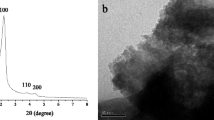Abstract
Cyanobiphenyl-mesogened liquid crystalline polymer is bonded on silica by surface-initiated atom transfer radical polymerization and is used as the stationary phase for liquid chromatography. Various instrumental analyses such as elemental analysis, X-ray photoelectron spectroscopy and differential scanning calorimetry were used for its characterization. The stationary phase exhibits multiple characteristics of low hydrophobicity, low hydrophobic selectivity, polarity recognition and shape selectivity in the separation of polyaromatic hydrocarbons and polar neural aromatic compounds. Temperature and mobile phase composition were confirmed to have effects on the chromatographic behavior. Isomers of polyaromatic hydrocarbons and carotenes are well separated on the stationary phase.











Similar content being viewed by others
Notes
“12.01”, “1.01”, “86.21”, “150.0”, “14.01”, “419.6” are the atomic/molecular weight of carbon atom, hydrogen atom, APS molecular fragment, BiBB molecular fragment and 11-(4′-Cyanophenyl-4″-phenoxy)undecyl acrylate, respectively. For each equation, the expression up the slash on the left stands for the mass of the element which matches the content on the right (see Table 1, elemental analysis) and the expression for division is the mass of the modified silica.
References
Kelker H (1963) Z Anal Chem 198:254. doi:10.1007/BF00486441
Witkiewicz Z (1982) J Chromatogr 251:331. doi:10.1016/S0021-9673(00)87023-5
Naikwadi KP, McGovern AM, Karasek FW (1987) Can J Chem 65:970. doi:10.1139/v87-165
Witkiewicz Z, Oszczudłowski J, Repelewicz M (2005) J Chromatogr A 1062:155–174. doi:10.1016/j.chroma.2004.11.042
Terrien I, Achard MF, Felix G, Hardouin F (1998) J Chromatogr A 810:19–31. doi:10.1016/S0021-9673(98)00198-8
Klein BH, Springer J (1991) J Liq Chromatogr 14:1519–1538. doi:10.1080/01483919108049633
Klein BH, Springer J (1991) J Liq Chromatogr 14:1539–1559. doi:10.1080/01483919108049634
Takafuji M, Rahman MM, Ansarian HR, Derakhshan M, Sakurai T, Ihara H (2005) J Chromatogr A 1074:223–228. doi:10.1016/j.chroma.2005.03.090
Gritti F, Terrien I, Menu S, Dufourc EJ, Felix G, Achard MF, Hardouin F (2001) J Chromatogr A 922:37–50. doi:10.1016/S0021-9673(01)00886-X
Gritti F, Felix G, Achard MF, Hardouin F (2001) J Chromatogr A 922:51–61. doi:10.1016/S0021-9673(01)00887-1
Gritti F, Felix G, Achard MF, Hardouin F (2000) J Chromatogr A 897:131–143. doi:10.1016/S0021-9673(00)00765-2
Gritti F, Felix G, Achard MF, Hardouin F (2001) J Chromatogr A 913:147–157. doi:10.1016/S0021-9673(00)01091-8
Gritti F, Felix G (2002) Chromatographia 55:523. doi:10.1007/BF02492897
Gritti F, Felix G (2002) Chromatographia 56:9. doi:10.1007/BF02490240
Gritti F, Sourigues S, Felix G (2002) Chromatographia 55:149. doi:10.1007/BF02492135
Gritti F, Felix G (2001) Chromatographia 53:201. doi:10.1007/BF02491571
Sander LC, Wise SA (1993) J Chromatogr A 656:335–351. doi:10.1016/0021-9673(93)80808-L
Sander LC, Lippa KA, Wise SA (2005) Anal Bioanal Chem 382:646–668. doi:10.1007/s00216-005-3127-2
Ferroukhi O (2000) Chromatographia 51:701. doi:10.1007/BF02505408
Shundo A, Sakurai T, Takafuji M, Nagaoka S, Ihara H (2005) J Chromatogr A 1073:169–174. doi:10.1016/j.chroma.2004.08.062
Mallik AK, Rahman MM, Czaun M, Takafuji M, Ihara H (2008) J Chromatogr A 1187:119–127. doi:10.1016/j.chroma.2008.02.011
Matyjaszewski K, Xia J (2001) Chem Rev 101:2921–2990. doi:10.1021/cr940534g
Edmondson S, Osborne VL, Huck WTS (2004) Chem Soc Rev 33:14–22. doi:10.1039/b210143m
He X, Yang W, Pei X (2008) Macromolecules 41:4615–4621. doi:10.1021/ma702389y
Zhang K, Li H, Zhang H, Zhao S, Wang D, Wang J (2006) Mater Chem Phys 96:477–482. doi:10.1016/j.matchemphys.2005.07.070
Chandrasekhar S (1992) Liquid crystals, 2nd edn. Cambridge University Press, Cambridge
Wang X, Zhou Q (2004) Liquid crystalline polymers. World Scientific Publishing, Singapore
Shoichi M, Ichioshi T (1983) New technology in liquid crystals. Kogyo Chosakai Publishing, Tokyo
Kasko AM, Heintz AM, Pugh C (1998) Macromolecules 31:256–271. doi:10.1021/ma971279f
Shibaev VP, Plate NA (1984) Adv Polym Sci 60:173. doi:10.1007/3-540-12994-4_4
Kasko AM, Grunwald SR, Pugh C (2002) Macromolecules 35:5466–5474. doi:10.1021/ma020242e
Pesek J (1989) Chromatographia 27:559. doi:10.1007/BF02258978
Schoenmakers PJ (1986) Optimization of chromatographic selectivity: a guide to method development. Elsevier, Amsterdam, p 67
Tran JV, Molander P, Greibrokk T, Lundanes E (2001) J Sep Sci 24:930–940. doi:10.1002/1615-9314(20011201)24:12<930:AID-JSSC930>3.0.CO;2-2
Engelhardt H, Jungheim M (1990) Chromatographia 29:59–68. doi:10.1007/BF02261141
Tanaka N (1989) J Chromatogr Sci 27:721–728
Galushko SV (1993) Chromatographia 36:39. doi:10.1007/BF02263833
Walters MJ (1987) J Assoc Off Anal Chem 70:465
Claessens HA, van Straten MA, Cramers CA, Jezierska M, Buszewski B (1998) J Chromatogr A 826:135–156. doi:10.1016/S0021-9673(98)00749-3
Yalkowsky SH, Valvani SC (1976) J Med Chem 19:727. doi:10.1021/jm00227a031
Acknowledgments
This work is supported by the National Natural Science Foundation of China (No. 20875096 and No. 20905072) and the Technology R&D Program of Gansu Province of China (No. 0804GKCA034).
Author information
Authors and Affiliations
Corresponding author
Rights and permissions
About this article
Cite this article
Wei, Z., Wang, L., Li, J. et al. Cyanobiphenyl-Mesogened Liquid Crystalline Polymer Bonded on Silica as the Stationary Phase with Shape and Polarity Recognition for LC. Chromatographia 73, 5–16 (2011). https://doi.org/10.1007/s10337-010-1834-0
Received:
Revised:
Accepted:
Published:
Issue Date:
DOI: https://doi.org/10.1007/s10337-010-1834-0




